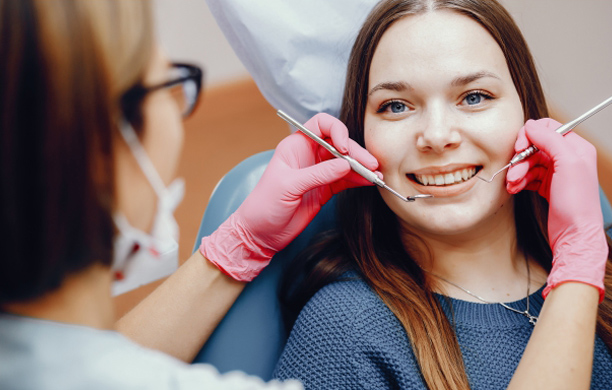Dental Prophylaxis
A dental prophylaxis is a cleaning procedure performed to thoroughly clean the teeth. Routine dental cleanings are important in stopping progression of periodontal disease and gingivitis.
Periodontal disease and gingivitis occur when bacteria from plaque colonize on the gingival (gum) tissue, either above or below the gum line. The bacteria colonies cause serious inflammation and irritation which produce a chronic inflammatory response in the body.
Then the body begins to systematically destroy gum and bone tissue, making the teeth shift, become unstable, or completely fall. The pockets between the gums and teeth become deeper and so house more bacteria. This bacteria may travel via the bloodstream and infect other parts of the body.

Reasons for prophylaxis/teeth cleaning
Prophylaxis is an excellent procedure to help keep the oral cavity in good health and also stop the progression of gum disease.
Benefits of teeth cleaning:
Tartar removal
Tartar (calculus) and plaque buildup, both above and below the gum line, can cause serious periodontal problems if left untreated. Even using the best brushing and flossing homecare techniques, it can be impossible to remove debris, bacteria and deposits from gum pockets. The experienced eye of a dentist or dental hygienist using specialized dental equipment is needed in order to spot and treat problems such as tartar and plaque buildup.
Fresher breath
Periodontal disease is often signified by persistent bad breath (halitosis). Halitosis is generally caused by a combination of rotting food particles below the gum line, possible gangrene stemming from gum infection, and periodontal problems. The removal of plaque, calculus and bacteria noticeably improves the breath and alleviates irritation.
Esthetics
Esthetics– It’s hard to feel confident about a smile flawed by yellow and stained teeth. Professional teeth cleaning removes these stains and gives a beautiful smile.
Identification of health issues
Many health problems first present themselves to the dentist. Since prophylaxis involves a thorough examination of the entire oral cavity, the dentist is able to screen for oral cancer, evaluate the risk of periodontitis and often spot signs of medical problems like diabetes and kidney problems. Recommendations can also be provided for altering the home care regimen.
Tartar removal
Tartar (calculus) and plaque buildup, both above and below the gum line, can cause serious periodontal problems if left untreated. Even using the best brushing and flossing homecare techniques, it can be impossible to remove debris, bacteria and deposits from gum pockets. The experienced eye of a dentist or dental hygienist using specialized dental equipment is needed in order to spot and treat problems such as tartar and plaque buildup.
Fresher breath
Periodontal disease is often signified by persistent bad breath (halitosis). Halitosis is generally caused by a combination of rotting food particles below the gum line, possible gangrene stemming from gum infection, and periodontal problems. The removal of plaque, calculus and bacteria noticeably improves the breath and alleviates irritation.
Esthetics
Esthetics– It's hard to feel confident about a smile flawed by yellow and stained teeth. Professional teeth cleaning removes these stains and gives a beautiful smile.
Identification of health issues
Many health problems first present themselves to the dentist. Since prophylaxis involves a thorough examination of the entire oral cavity, the dentist is able to screen for oral cancer, evaluate the risk of periodontitis and often spot signs of medical problems like diabetes and kidney problems. Recommendations can also be provided for altering the home care regimen.
Professional teeth cleaning is generally performed in several stages:
Prophylaxis is recommended twice annually as a preventative measure, but should be performed every 3-4 months on patients with periodontal disease. Though gum disease cannot be completely reversed, prophylaxis is one of the tools the dentist can use to effectively stop its dangerous progress.
1. Supragingival cleaning – The dental hygienist will thoroughly clean the area above the gum line with scaling tools to remove plaque and calculus.
2. Subgingival cleaning – This is the most important step for patients with periodontal disease because calculus from the gum pockets and under the gum line is removed.
3. Root planning – This is the smoothing of the tooth root by the dentist or dental hygienist to eliminate any remaining bacteria. These bacteria are extremely dangerous to periodontal patients.
4. Medication – Following scaling and root planning, the pockets are irrigated with an antibiotic rinse such as chlorohexidine.
5. X-ray and examination – Routine X-rays can be extremely revealing when it comes to periodontal disease. X-rays show the extent of bone and gum recession, and also aid the dentist in identifying areas which may need future attention.
Professional teeth cleaning is generally performed in several stages:
Prophylaxis is recommended twice annually as a preventative measure. Should be performed every 3-4 months on patients with periodontal disease. Though gum disease cannot be completely reversed. Prophylaxis is one of the tools the dentist can use to effectively stop its dangerous progress.
1. Supragingival cleaning – The dental hygienist will thoroughly clean the area above the gum line with scaling tools to remove plaque and calculus.
2. Subgingival cleaning – This is the most important step for patients with periodontal disease because calculus from the gum pockets and under the gum line is removed.
3. Root planning – This is the smoothing of the tooth root by the dentist or dental hygienist to eliminate any remaining bacteria. These bacteria are extremely dangerous to periodontal patients.
4. Medication – Following scaling and root planning, the pockets are irrigated with an antibiotic rinse such as chlorohexidine.
5. X-ray and examination – Routine X-rays can be extremely revealing when it comes to periodontal disease. X-rays show the extent of bone and gum recession, and also aid the dentist in identifying areas which may need future attention.



